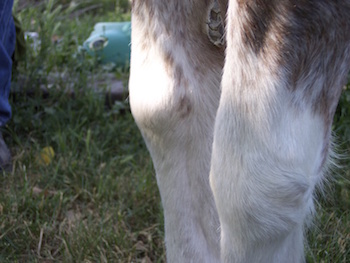
How would you feel if you were forced to walk around all day on metal shoes? I know- that my knees, ankles, and even my back would be killing me by the end of the day. I would not be happy the next day- in fact I probably would not even get out of bed. For all of us that have owned horses for awhile, we all know and understand that one of the reason we put older horses down, is because they have arthritis in their joints so bad that they can’t hardly even walk. (In my opinion, because they have been pounding on metal their whole lives) Shoe hits hard surface, rock, pavement, ground, sending a jarring vibration all the way up the leg and even effects the back.
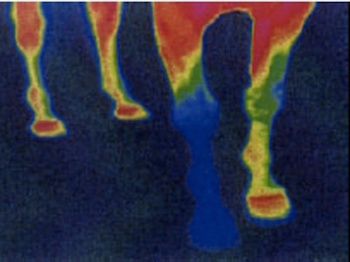
A horses hoof is made to expand and contract. As the horse steps on his hoof it expands sending a rush of blood through the hoof. As the horse picks it’s hoof up the hoof contracts. Some people will even say that the horse has five hearts: four hoof pumps and their normal heart. This really aids in the overall health of a horse. A metal shoe is nailed on the bottom of the horse’s hoof while it is in a contracted position. As the horse steps on the hoof, the shoe is holding the foot in a contracted position. Hence- restricting blood flow. And I ask “What feeds the bones in the foot?” Blood. So, with metal shoes there is less blood flow. Without shoes, there is no restriction occurring and the blood flows. This aids in all hoof problems… navicular, founder, recessed frogs, thrush etc…
The hoof is much healthier in it’s “Natural” state. Inside the hoof there are bone, tissue, and blood vessels. All of which are in danger with a nailed on shoe or over grown hoof wall let alone the legs and body. With natural hoof care we are mimicking the hooves of wild horses. On average, a wild horse moves 20 or more miles a day. This traveling through rocky and varied terrain wears the hoof and keeps it hard. As a natural hoof care provider, My goal is to use my tools to do what the rocks and varied terrain would do naturally. This is why it is so important to keep the horses on a trimming schedule.
In my experience, trimmings should occur 4 weeks during the summer and up to 6 weeks during the winter. This is for healthy horses. More frequent trims may be necessary for horses with problem feet. With this said, my personal horses are on a 3 week schedule. I like this because the more often I trim the less I have to do. (easier on my back and on the horses) The more often a trim is done, the easier it is on the tendons and suspensory ligaments because there is not much of a change in angles. Imagine your horse never having cracks, breaks,or flared hoof walls.
Free choice grass hay, salt block, mineral block, and water. Spread out the hay so that they have to move to eat.
Alfalfa= cow hay
Grass Hay= horse hay
Diet and movement probably play the biggest part in Natural Hoof Care. As a wild horse travels, they eat a tuft of grass, then walk, eat a twig, then walk, eat a leaf, and so on. They are always moving and browsing 15-20 hours a day. This is our goal with our horses. Feeding free choice grass hay, salt block, and a mineral block are a few of the ways we can prevent major hoof problems that plague our domesticated horses. It is very rare that, founder, navicular, thrush, and other hoof problems are ever found in the wild horses. Prevention is our goal.
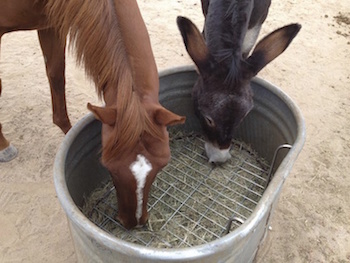
The best way I have found to help horses “browse” is by the use of slow feeders. These slow the horse down from feeding too fast and eating too much. This helps the horse not to colic too. Keeping food in front of the horse all the time (which is very natural) helps the digestive system keep in motion by providing feed at all times. It also aids in boredom. The horse can eat for awhile, walk around, eat again, play with its friends, eat again, take a nap, eat again, go for a ride, eat again…
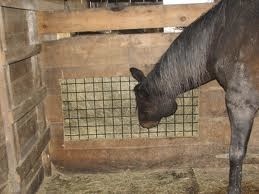
Use your imagination!!!! Almost anything you have already laying around can be used. I like the heavy field fencing that is 2x4 rectangles. But, this is something you need to experiment with and see what works for your horses. Go to slow feeder link to see more examples.
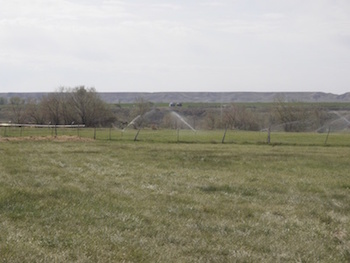
Less trips to the feed store is the best! Most horses do not need supplements and grains. Pasture is high in sugar levels and is not the best choice for all day living conditions. Turn out to pasture only between the hours of three a.m. to ten in the morning. This is when the sugar levels are not as high. Because of photosynthesis the sugar levels in the grass drop down by the roots when the sun goes down, and then rise durning the day when the sun is shining. So, when most people get home from work about 5:00p.m. they are turning their horses out to pasture to eat “twinkies”.
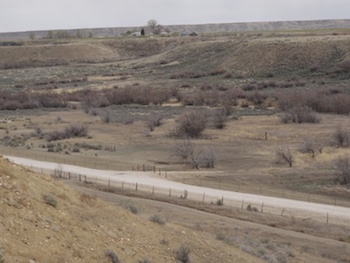
With our horses, we turn them out to the pasture at 6:30 a.m. in the morning and put them back in their paddock of paradise about 9:30 a.m. Then they browse during the afternoon until I feed them grass hay about 6:00 p.m. (My horses can browse on their own because their paddock of paradise is about 3 acres.)
Natural Hoof Care is all about movement, which is very “Natural”. This is a way to exercise the horse without having to ride it constantly. According to Dr. Thomas G. Teskey D.V.M. “Healthy horses can work over any terrain, if conditioned on that type of terrain.” Have the horses live in their riding condition.
An idea that was formed by Jamie Jackson called “Paddock Paradise” is a great way to care for a horse's hooves. Paddock Paradise provides movement that the horse needs so drastically to help keep the hooves strong and healthy. It provides a “Track” all the way around the outside edge of a pasture, paddock, or arena. The track can be anywhere from 10 feet wide to 40 feet wide, used as a loafing area. Rocks, logs, and pea gravel are put in the track to toughen the hooves and allow drainage of excess water. Hay piles are spread out in all corners so that the horses are required to move. Studies show that the average horse takes between 16,000 - 18,000 steps a day in a Paddock Paradise, 4,000 - 6,000 in a regular paddock, and only 800 steps a day in a stall. (Dr. Bowker clinic January 2007)
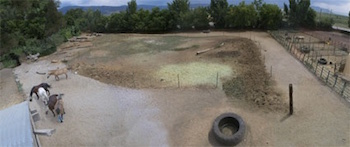
I built this for my personal horses when I lived in the city and had minimal ground for them to move around on. I was amazed by the changes in their feet. My horses circled the track all day long exercising themselves. Horses naturally want somewhere to go- you just need to supply it for them. I trimmed less off of their hooves every trim. This makes their feet that much stronger. I used electric fencing in the middle, it is inexpensive and very easy to install. I added pea gravel, cobble stone, one inch gravel, sand, and built a little forest of logs for them to cross over. Also, some logs they had to walk around. Of course, I spread out their feed so they had to move. Use your imagination!!!!! Any thing goes. If your horse is scared of mail boxes-add one. How about tarps? Railroad ties built up into a small hill. Keep it clean.
Get the horses out of the mud! Haul in some material to give the hooves a dry out and hardening place. Hooves do need moisture- not manure. Water area down by water trough or have them drink out of a creek or pond. All the rest of the Paddock should be dry (All Year).
Ride a lot!!!!!
Natural Hoof Care is all about movement, which is very “Natural”. This is a way to exercise the horse without having to ride it constantly. According to Dr. Thomas G. Teskey D.V.M. “Healthy horses can work over any terrain, if conditioned on that type of terrain.” Have the horses live in their riding condition.
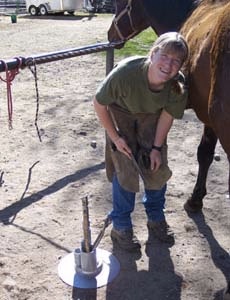
I began shoeing horses when I was about 14 years old. I would help my father while he was shoeing our horses. After some time had passed, he would shoe one horse and I would shoe the other and that was the beginning of my “farrier” experience. Eventually, a few neighbors asked if I would shoe their horses. I wanted to do it correctly, so I started studying and doing small apprenticeships with local farriers, mostly it was trial and error. I labored for 10 years as a professional farrier.
In 2006, I acquired, from a friend, a foundered horse that was way too sore to walk. After visiting with my veterinarian, I was cautioned to put the horse down. However, I just had to try to save him. I began trimming his hooves just like I did with all my other horses. But after a few months of soaking and trimming, his hooves weren't getting better and I was even more frustrated. One day, I was visiting with another friend when a lady lent me her book “Making Natural Hoof Care Work For You” by Pete Ramey to help me with my foundered horse. I took the book and then forgot about it. Well, the time came to return it and I had not read it. So, I picked it up and started reading it. I was Hooked! I tried the methods on my foundered horse and they worked! So, I tried them on my two navicular horses and they worked. Lastly, I started using them on all of my horses and the results were amazing. In just a short time, I had converted all my shoeing clients.
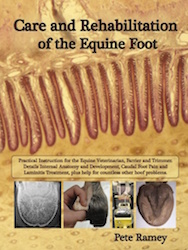
I have attended 2 Pete Ramey clinics, an Easy Care Clinic, a Dr. Bowker clinic, and a Katy Watts nutrition clinic. I have watched all the Pete Ramey videos (some lots of times). Right now I am reading and studying his new book “Care and Rehabilitation of the Equine Foot”.
My husband and I have 4 children which often come to help me on my jobs.